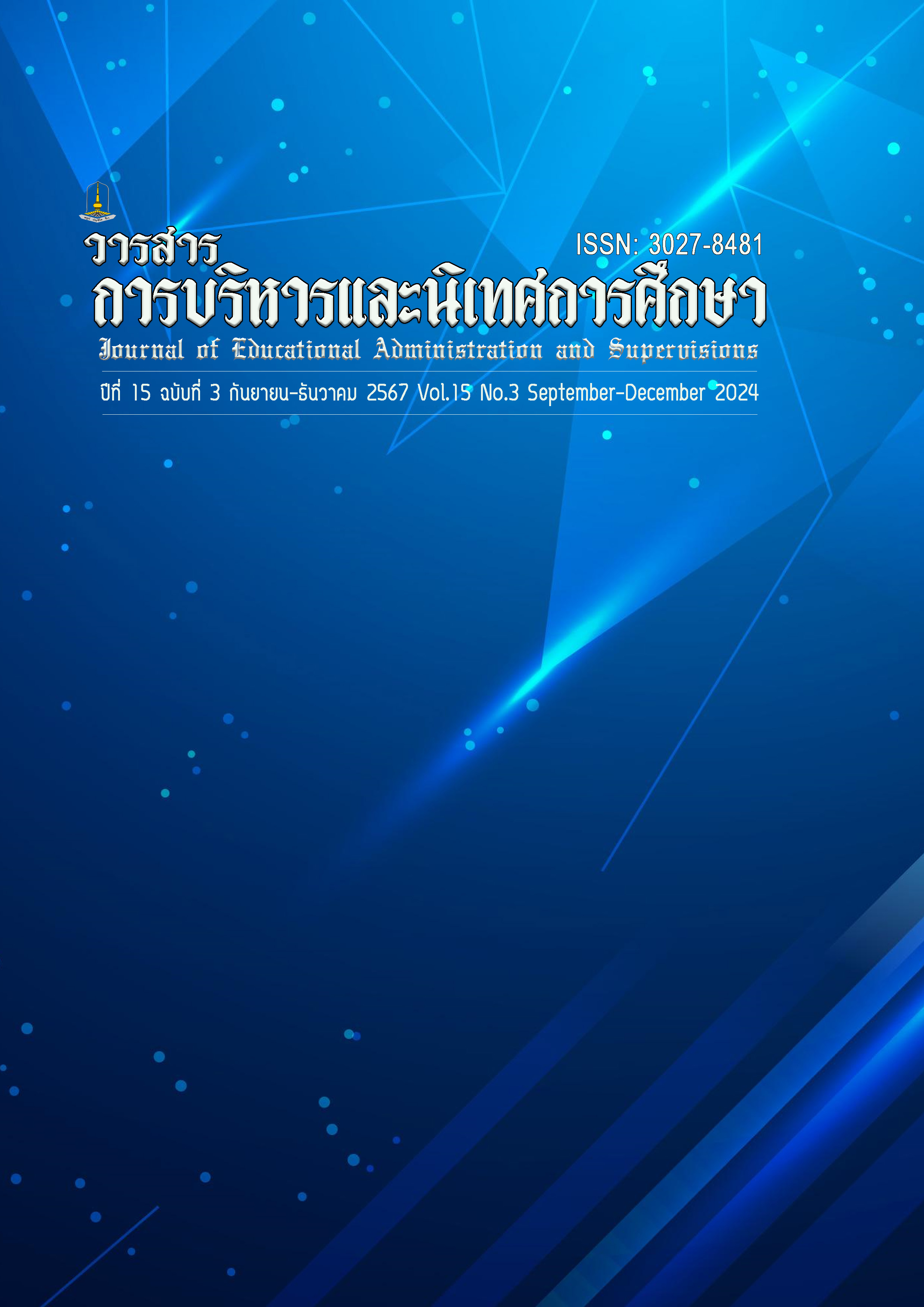Learning Management in the 21st Century Affecting Students’ Skills in Schools under Bueng Kan Primary Educational Service Area Office
Main Article Content
Abstract
The purposes of this research were 1) to study and compare learning management
in the 21st century classified by status and school size, 2) to study and compare students’
skills in schools classified by status and school size, 3) to study the relationship between learning management in the 21st Century affecting students’ skills in schools under Bueng
Kan Primary Educational Service Area Office, and 4) to study the predictive power for learning management in the 21st century affecting students’ skills in schools under Bueng Kan primary educational service area office. The simples consisted of 363 including 31 school
administrators and 332 teachers followed the percent criterion in sample size specification,
and they were selected by Stratified Random Sampling. The instruments used were 2 aspects of five-rating scale questionnaires: 1) a questionnaire about learning management in the 21st century with the Index of Item Congruence (IC) between .60-1.00, the discrimination between .56-.83, and the reliability of .98; and 2) a questionnaire about students’ skills in schools with the Index of Item Congruence (IC) between .60-1.00, the discrimination between
.61-.81, and the reliability of .98. The statistics employed were percentage, mean, standard deviation, t-test (Independent Samples), One-way analysis of variance, Pearson's correlation
coefficient, and multiple regression stepwise analysis.
The results of the research showed that (1) the overall learning management in the
21st century was at the high level. In comparison, the overall Learning management in the 21st century classified by status revealed the statistically significant not different. The overall school size revealed the statistically significant different at the .05 level. (2) The overall Students’ Skills in Schools was at the high level. In comparison, the overall Students’ Skills in Schools classified by status and school size revealed the statistically significant not different. (3) The learning management in the 21st century and Students’ Skills in Schools revealed quite high significant positive correlation at the .01 level. (4) There were 3 variables of learning management in the 21st century that affected Students’ Skills in Schools under Bueng Kan Primary Educational Service Area Office: media and technology (X3), learning environment (X4), and morality ethics (X6). They could be predicted up to 55 percent. The
equation can be written as follows:
Forecasting equation in raw scores
Y' = .49 + .34X3 + .31 X4 + .18X6
Forecasting equation in standard scores
Zy' = .36Z3 + .32Z4 + .19Z6
Downloads
Article Details
References
เจริญพงษ์ ชมภูนุช. (2563). ปัจจัยที่ส่งผลต่อทักษะการเรียนรู้ในศตวรรษที่ 21 ด้านการคิดอย่างมีวิจารณญาณและการแก้ปัญหาของนักเรียนระดับมัธยมศึกษาตอนปลาย แผนการเรียนวิทยาศาสตร์-คณิตศาสตร์. [การค้นคว้าอิสระปริญญามหาบัณฑิต ไม่ได้ตีพิมพ์]. มหาวิทยาลัยนเรศวร.
ณิรดา เวชญาลักษณ์. (2561). หลักการจัดการเรียนรู้. โรงพิมพ์แห่งจุฬาลงกรณ์มหาวิทยาลัย.
นันทนัช สุขแก้ว และคณะ. (2563). ทักษะครูในยุคดิจิทัลของโรงเรียนสุรศักดิ์มนตรี สังกัดสำนักงานเขตพื้นที่ การศึกษามัธยมศึกษา เขต 2. การประชุมวิชาการนำเสนอผลงานวิจัย (Symposium) ระดับบัณฑิตศึกษาครั้งที่ 12 ในวันเสาร์ที่ 28 มีนาคม 2563 ณ อาคารบัณฑิตวิทยาลัย มหาวิทยาลัยราชภัฏ อุบลราชธานี. บัณฑิตวิทยาลัย มหาวิทยาลัยราชภัฏอุบลราชธานี, 70-79.
บุญชม ศรีสะอาด. (2560). การวิจัยเบื้องต้น. พิมพ์ครั้งที่ 10 (แก้ไขเพิ่มเติม). สุวีริยาสาส์น.
เบญจวรรณ กลั่นศรี. (2564). แนวทางการพัฒนาระบบสนับสนุนการเรียนรู้สำหรับศตวรรษที่ 21 ของ สถานศึกษา สังกัดสำนักงานเขตพื้นที่การศึกษามัธยมศึกษาเขต 3 จังหวัดพระนครศรีอยุธยา. [วิทยานิพนธ์ปริญญามหาบัณฑิต ไม่ได้ตีพิมพ์]. มหาวิทยาลัยราชภัฏพระนครศรีอยุธยา.
พิชากรณ์ เพ่งพิศ. (2563). ปัจจัยที่ส่งผลต่อทักษะของผู้เรียนในศตวรรษที่ 21 ของนิสิตระดับปริญญาตรี มหาวิทยาลัยเกษตรศาสตร์ วิทยาเขตกำแพงแสน. [วิทยานิพนธ์ปริญญามหาบัณฑิต ไม่ได้ตีพิมพ์]. มหาวิทยาลัยศิลปากร.
ลัดดาวัลย์ สะอิ้งทอง. (2564). แนวทางการพัฒนาทักษะการจัดการเรียนรู้ของครูในศตวรรษที่ 21 สังกัด สำนักงานเขตพื้นที่การศึกษาประถมศึกษาสุพรรณบุรี เขต 1. [วิทยานิพนธ์ปริญญามหาบัณฑิต ไม่ได้ ตีพิมพ์]. มหาวิทยาลัยราชภัฏพระนครศรีอยุธยา.
สุคนธ์ สินธพานนท์. (2558). การจัดการเรียนรู้ของครูยุคใหม่เพื่อพัฒนาทักษะของผู้เรียนในศตวรรษที่ 21. 9119 เทคนิคพริ้นติ้ง.
สำนักงานเขตพื้นที่การศึกษาประถมศึกษาบึงกาฬ. (2565). แผนปฏิบัติการประจำปีงบประมาณ 2565. สำนักงานเขตพื้นที่การศึกษาประถมศึกษาบึงกาฬ.
อรอุษา วงศ์จรัสเกษม. (2562). ทักษะการจัดการเรียนรู้ของครูในศตวรรษที่ 21 สังกัดสำนักงานเขตพื้นที่ การศึกษาประถมศึกษาสมุทรสาคร. [วิทยานิพนธ์ปริญญามหาบัณฑิต ไม่ได้ตีพิมพ์]. มหาวิทยาลัยราชภัฏนครปฐม.
Likert, R. (1967). The Method of Constructing and Attitude Scale. Attitude Theory and Measurement. Fishbeic, Martin, Ed. Wiley & Son. P.90-95.


